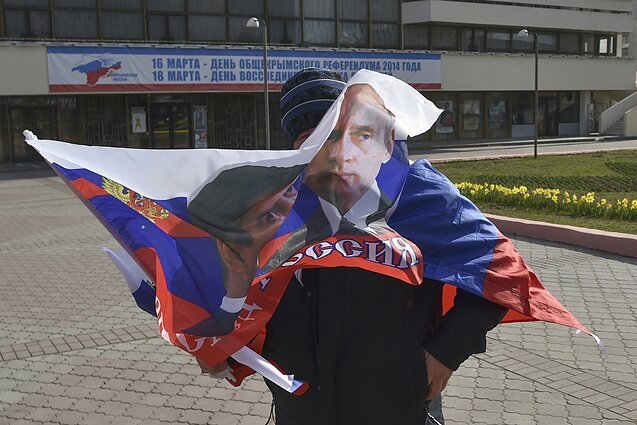Propagandists claim that since Sevastopol had the status of a republican city in the Russian Soviet Federative Socialist Republic (RSFSR), it should have been transferred by a special act to the Ukrainian SSR, separately from the Crimean region.
And since there was no special order, Sevastopol is said to have “always been Russian”.
However, this claim fundamentally contradicts the Soviet legislation on which Moscow is trying to base its current claims.
If not Crimea, then at least Sevastopol
Appears constantly on social networks publicationsthey are “legally” Sevastopol has always been part of the RSFSR and never belonged to Ukraine.
The popularization of this myth was largely contributed by the Russian dictator Vladimir Putin, whose position is stated in the official Russian media, and especially emphasized in the special publication Parlamentskaja gazeta (lit. “Parliament newspaper”).
“V. Putin drew attention to the fact that, legally, this Crimean city has always been part of the Russian Federation. He reminded that even during the illegal transfer of Crimea from the RSFSR to the Ukrainian SSR, Sevastopol was a city under central control.
The President specified that according to the law this decision had to be approved by the Supreme Soviet of the USSR and the Supreme Soviets of the republics.
However, as the Russian leader noted, even in this fundamentally illegal process, “Sevastopol was simply forgotten, it was not transferred from the RSFSR to Ukraine. Thus, formally and legally, it has always been a part of the Russian Federation.”
In subsequent propaganda publications, this thesis was essentially repeated over and over, despite its obvious untruth.
Rights of republics
The Soviet Union, according to its founders, was to be a federation or even a confederation of sovereign Soviet republics, each of which retained the right to freely secede from the USSR.
This principle was reflected in 1936. (also known as Stalin’s) Constitutions Articles 14, 15 and 17 and 1978 (Brezhnev) Constitutions Chapters 8 and 9.
For this reason, each republic was considered completely independent in all areas – including matters of internal organization and the determination of internal administrative boundaries – except for those powers which were constitutionally delegated to a pan-Union leadership.
In addition, their borders could not be changed without the consent of the republics.
All these rights, which were really nominal, presupposed the observance of certain legal procedures, which, though formal, were nevertheless enforced.
Autonomy of Sevastopol
In the legislation of the Soviet Union, the concept of “city under union (or central) subjugation” was basically included.
Instead, another concept with more or less clear legal content was used: city under republican rule.
And in 1948 The Presidium of the Supreme Council of the RSFSR actually issued decree no. 762/2which consisted of one sentence:
“To establish the city of Sevastopol as an independent administrative and economic center with its own special budget and assign it to the category of cities under republican authority.”
The autonomy of Sevastopol was manifested in the fact that since then it had its own budget, separate from the Crimean region.
1948-1954 legislative and administrative documents do not record any other signs of special status.
For example, in 1953 At the meetings of the Crimean Regional Council participated and deputies elected from Sevastopol – it is obvious that if this city was considered an independent entity, it could not be.
All legal procedures were followed
Despite the interpretations spread by V. Putin, the transfer of Crimea to Ukraine took place in compliance with all the requirements of the Soviet Constitution.
The first legal step here was in 1954. February 5 RSFSR Ministers Council resolution:
“The Council of Ministers of the RSFSR decides:
Transfer the Crimea region from the RSFSR to the composition of the Ukrainian SSR.
To ask the Presidium of the Supreme Council of the RSFSR to consider the issue of the transfer of the Crimea region to the Ukrainian SSR and to record the relevant resolution in the Presidium of the Supreme Council of the RSFSR”.
This means that the initiative came from the authorities of Soviet Russia.
The Presidium of the Supreme Council of the USSR – in accordance with the 1936 Article 14 of the Constitutionapproved the transfer of Crimea to the Ukrainian SSR.
Internal administrative (specifically, budgetary) issues of the Crimean region were not separately regulated in any way.
At the same time, in the Constitution of the RSFSR, Sevastopol after 1954 was not named as a republican city. However, in 1978 Ukrainian SSR Article 77 of the Constitution Kyiv and Sevastopol are defined as cities under republican control.
Obviously, from the point of view of the Soviet authorities, Sevastopol was part of the Crimean region, but it had some administrative and economic autonomy.
in 1954 After the transfer of Crimea to Ukraine, Sevastopol also became part of the Ukrainian SSR, but retained the status of a republican city – but already within Soviet Ukraine.
Therefore, according to the legislation of the USSR and its successor, the Russian Federation, there is no legal basis for holding Sevastopol de jure of Russia.
15min verdict: lie. There is a direct distortion of historical facts and legal definitions.
The publication was prepared in 15 minutes in partnership with Metawhich aims to stop the spread of misleading news on the social network. More about the program and its rules – here.
Source: www.15min.lt





